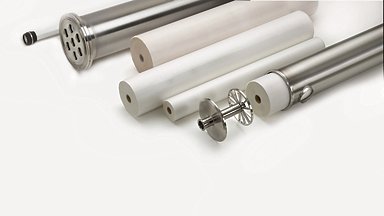Maximise value and quality in milk-based products
Membrane filtration allows milk to be fractionated into its constituent components, which can then can be used to produce a wide spectrum of products. Membrane filtration is also effective at removing bacteria and spores, and is frequently used to standardise protein and casein content.
Additionally, milk producers deploy membrane filtration to concentrate their product into a smaller volume, thereby saving costs during transportation.
Premium milk with natural taste and extended shelf life
Our bactocatch solution removes 99,9999% of bacteria and spores in milk, using a ceramic membrane filtration unit and HTT (high-temperature treatment) of cream. You can use the unit for efficient removal of bacteria and spores in chilled milk and in cheese milk to obtain premium quality end products.
Premium milk with natural taste and extended shelf life
Our bactocatch solution removes 99,9999% of bacteria and spores in milk, using a ceramic membrane filtration unit and HTT (high-temperature treatment) of cream. You can use the unit for efficient removal of bacteria and spores in chilled milk and in cheese milk to obtain premium quality end products.
Uses and technologies

WHEY AND KEY COMPONENT SEPARATION
WPI, lactose and more
Membrane filtration is effective at concentrating dairy products such as cheese and cultured products. It is also useful for isolating target components for high-value whey-based ingredients. Permeate streams containing native whey proteins can be further processed into higher value protein products such as whey protein isolate (WPI) or various grades of whey protein concentrate (WPC). Filtration permeate from milk ultrafiltration and microfiltration consists primarily of lactose, a favoured ingredient in milk powder standardisation. Whey-based ingredients are a fast-growing dairy segment. Products include lactoferrin, calcium phosphate, lactose, permeate powder and hydrolysates. Mineral-based ingredients serve as components in nutritional supplements, lactose-based ingredients occur in snack, confectionary and nutritional products, and hydrolysates form part of infant formula and dietary products.

Initial concentration
Reverse osmosis
Reverse osmosis filtration is used for initial concentration before other processes or prior to transportation, thereby reducing volume transport costs. Using the finest possible membranes, reverse osmosis filtration essentially allows water only to pass. All other liquid or suspended components, including bacteria, fats, proteins, sugars and minerals, are filtered out as retentate. High pressure is applied to the liquid during the reverse osmosis filtration process.

Ion and mineral removal
Nanofiltration
The diluted streams from microfiltration and ultrafiltration processes are often concentrated using nanofiltration or reverse osmosis – or a combination of the two. The nanofiltration process removes or recovers water and also separates monovalent ions, thus demineralizing the product. Nanofiltration plays a role in the production of products such as milk protein concentrate (MPC), milk protein isolate (MPI) and infant formula. The technology uses slightly more open membrane pores than reverse osmosis. These allow small ions such as dissolved minerals to pass but exclude larger ions and most organic components such as bacteria, spores, fats, proteins, gums and sugars.

Fat and protein separation
Ultrafiltration
Ultrafiltration is used for concentrating large molecules such as fat and protein in raw or pasteurized whole or skim milk and for reducing lactose and mineral content. Typical products include milk protein concentrate (MPC) and milk protein isolate (MPI). These are produced using polymeric spiral membranes. Diafiltration is often used here to increase the protein-to-dry-matter ratio to achieve high-grade varieties such as MPC 85. Ultrafiltration is also used to concentrate whole or standardized milk for the production of fully or partially concentrated cheeses. Ultrafiltration membrane pores are larger than in nanofiltration and the pressure applied is relatively low. Salts, sugars, organic acids and smaller peptides pass through as permeate. Proteins, fats and polysaccharides remain as retentate.

Skim milk processing
Microfiltration
Microfiltration primarily serves two purposes: removing bacteria and spores from skim milk, and separating skim milk proteins into a casein stream and a serum protein stream. Microfiltration membranes have the largest pore size of the four main dairy filtration technologies. They allow most substances to pass except suspended solids, bacteria and fat globules. In casein separation, the membranes retain large casein micelles, letting smaller serum proteins pass. Casein concentrate is produced either using polymeric spiral membranes or with ceramic membranes, depending on the application.









